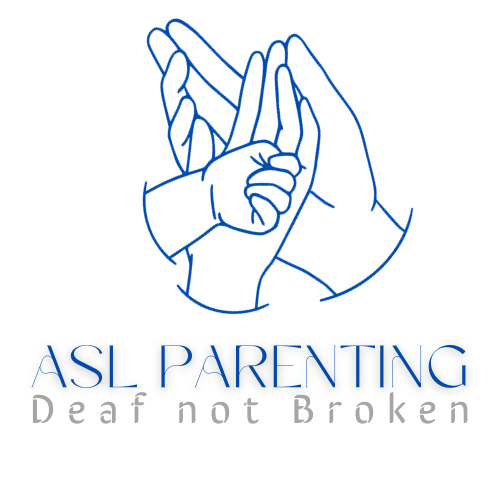Welcome to “ASL Parenting” the site that delves into the diverse and vibrant world of deaf culture and advocacy. Today we’re going to discuss The Importance of Early Communication for Deaf Children.
Starting out Strong
To truly understand the significance of early communication for deaf children, we must recognize the impact it has on their entire lives. It’s not just about teaching them to communicate; it’s about ensuring they have the same opportunities and experiences as their hearing peers.
Family Integration
One of the key aspects of early communication is family integration. Deaf children benefit greatly from a home where communication is accessible and engaging. Think about how hearing children learn English from their parents without formal lessons, only daily exposure; the same holds true for deaf children and American Sign Language (ASL).
Passive Learning
Just as hearing children absorb language naturally, deaf children can passively learn ASL in a family where it’s used consistently. It’s about creating an environment where ASL is the language of love, comfort, and daily life.
That can be done with signed tv programs for kids and signing to them directly, but it will also require you to sign when they are around, even when you’re not talking to them. How often do you talk openly around your hearing family and allow them to pick up new words, phrases and complex speech patterns like humor? What would their lives be like if the only time they heard your words were when you were speaking to them directly? What would your life be like now if you grew up that way? It’s important for you to learn vocabulary, signs and gestures, eventually finger-spelling and ASL grammar.
A Bilingual Advantage
Bilingualism, for deaf children, means proficiency in both ASL and English. The ability to passively learn ASL at home equips them with a strong foundation for developing English skills, essential for success in education and life. ASL doesn’t work like English, the rules are more European, because it’s based on French Sign Language, which is based on spoken French. That grammar lends itself better to signs anyway, because like a painting it focuses on broad strokes before details.
Ex:
“There is a cat in that tree over there”
Paint the tree in the distance then the cat on a branch.
“OVER-THERE TREE, CAT SIT (up high). “
Without a basis in ASL, they will not be able to recognize or learn the difference in English and they may always struggle to read and comprehend English.
Building Strong Bonds
Early communication isn’t just about language; it’s about building strong bonds. Deaf children who can communicate effectively with their family members experience a sense of belonging and security that is vital for their overall development. During the era of residential schools for the deaf (basically European boarding schools), students would report that they felt a closer kinship to their instructors, staff and peers than to their families, not because of the amount of time spent with one than the other, but because of the ability to communicate with people who understood them and what they were going through. Schools like this are transitioning into daily schools where the kids go home each evening, like a mainstream school but for the deaf, or residential for the week and back home on the weekends for the deaf students that live too far away for daily travel.
Is it important to you who raises your kids? What they are teaching them? What personal advice they are giving when your child has questions or problems? Historically the trade off has been send them away to learn their language and form connections with their own community and maintain a marginal connection with them as a member of the family, or keep them home force them to try and learn a language they will never be able to hear or properly produce and will struggle to read and take care of them for the rest of their lives. It doesn’t have to be that way, it’s not that black and white. Most importantly, you don’t need to be perfect at ASL, especially when your kids are very young, but you need to progress as they do, so they can talk to you about more and more complex and personal subjects in their youth and adulthood.
Challenges Along the Way
Host: While the concept of early communication through ASL sounds promising, it’s not without challenges. Many hearing parents of deaf children may not initially be familiar with ASL, but there are resources and support available to help them embark on this journey. Our website will continually be providing tutorials, conversations, interviews and resources that you can use, but there will be local resources that you can reach out to from your deaf community to learn what your children will need to keep both their family life and their personal development on track, but it all starts with you.
The Impact on Deaf Children’s Lives
The impact of early communication is profound. Deaf children who have the opportunity to learn ASL from their parents alongside their hearing siblings often exhibit higher levels of self-esteem, better academic performance, and a stronger sense of identity within the Deaf community. It will be up to you to find and incorporate elements of the Deaf community into your home, with adult examples and other deaf and children of the deaf to make your child feel like there is a future and a community for them outside of the home they are growing up in. If you show that you support them now, they will trust your support later and eventually they will be able to act independently of your support; because you broke down the barriers in their way from an early age.
Breaking Down Barriers
Early communication is not just about preparing a child for their future; it’s about clearing the path for them to continue down in the future. Breaking down barriers today enables deaf children to participate in family conversations, engage in playdates with their hearing siblings, and build bridges with the hearing world. It also gives them a structure to follow when reaching out to the Deaf community to build friendships and relationships that will last the rest of their lives.
Resources and Support
To parents who are just beginning this journey, know that you’re not alone. There are organizations, support groups, and educational resources available to guide you in fostering early communication through ASL.
Food for Thought
As we conclude this episode, it’s clear that early communication for deaf children is not just a choice; it’s a fundamental right. By passively learning ASL at home, these children are equipped to flourish in a world full of opportunities.
Thank you for joining us on “ASL Parenting”. We hope this episode has shed light on the importance of early communication and its profound impact on the lives of deaf children. Stay tuned for more engaging conversations about the Deaf community and its remarkable journey.
If you found this article inspiring and informative, please share it with others who may benefit. Remember, it’s through understanding and dialogue that we can make the world a more inclusive place for everyone. Until next time, remember, your child isn’t broken, they’re just deaf. You don’t have to fix them you just have to learn their language.



